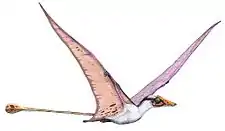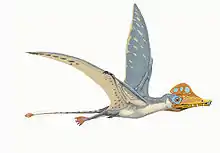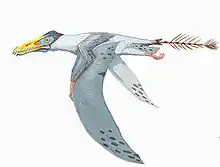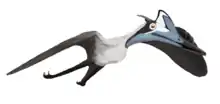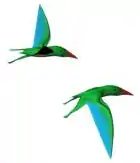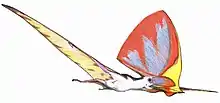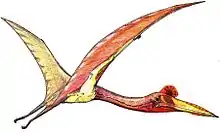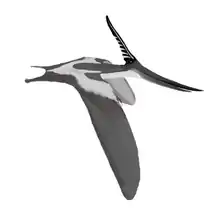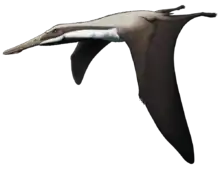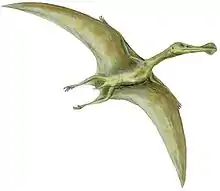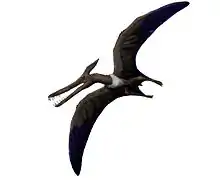Pangupterus
Pangupterus (meaning Pangu wing) is a genus of pterodactyloid pterosaur from the Early Cretaceous Jiufotang Formation of China. It was first described and named by Lü Junchang et al.[1]
| Pangupterus | |
|---|---|
| Scientific classification | |
| Kingdom: | Animalia |
| Phylum: | Chordata |
| Order: | †Pterosauria |
| Suborder: | †Pterodactyloidea |
| Genus: | †Pangupterus Lü et al., 2016 |
| Species: | †P. liui |
| Binomial name | |
| †Pangupterus liui Lü et al., 2016 | |
It is known from a mostly-complete lower jaw, which bears 36 slender, evenly-spaced, conical teeth jutting out at an angle on its tip. Some teeth are smaller than the others, and appear to be replacement teeth. Such teeth are not seen in any other toothed pterosaurs from the Jiufotang Formation with comparable material, and this specialized dental morphology is indicative of a piscivorous lifestyle.[1]
Although no phylogenetic analysis was conducted to determine its affinities, Pangupterus has a small process, called an odontoid, on the end of the maxilla; such a process is also seen in the istiodactylids Longchengpterus and Istiodactylus.[1][2]
References
- Lu, J.; Liu, C.; Pan, L.; Shen, C. (2016). "A New Pterodactyloid Pterosaur from the Early Cretaceous of the Western Part of Liaoning Province, Northeastern China". Acta Geologica Sinica. 90 (3): 777–782. doi:10.1111/1755-6724.12721.
- Martill, D. (2014). "A functional odontoid in the dentary of the Early Cretaceous pterosaur Istiodactylus latidens: Implications for feeding". Cretaceous Research. 47: 56–65. doi:10.1016/j.cretres.2013.11.005.
